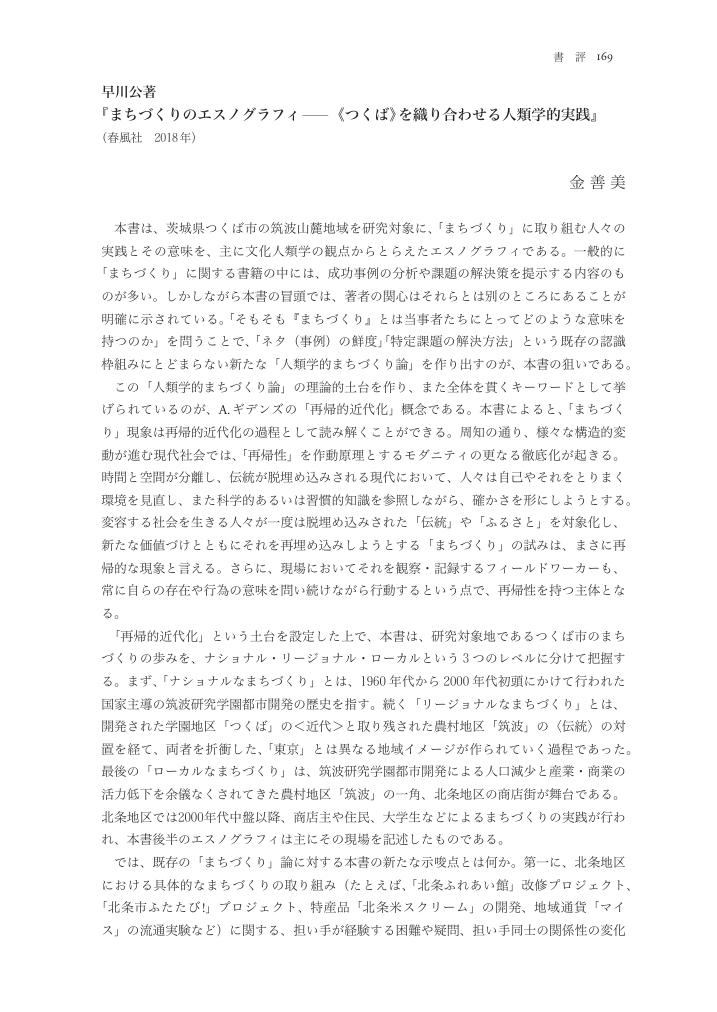- 著者
- 金 善美
- 出版者
- 日本都市社会学会
- 雑誌
- 日本都市社会学会年報 (ISSN:13414585)
- 巻号頁・発行日
- vol.2012, no.30, pp.43-58, 2013-09-01 (Released:2014-03-07)
- 参考文献数
- 23
- 被引用文献数
- 2 2
This paper aims to examine the role of Art in revitalizing city's run-down area. For this purpose, this paper draws upon empirical work in Mukoujima, known as former industrial zone and typical ‘Shitamachi' area of east Tokyo. Art movement in Mukoujima started at late 1990s. At the first time, it was experimental solution for abandoned houses and shops, mainly to reduce the risk of arson. However, the movement has continued for 10 years, bringing more and more young artists and trendy places for them. Up to now, Mukoujima gradually came to be known as “Hidden Art town in Tokyo's traditional area”. By analyzing the interaction of various actors, this paper reveals two points. Firstly, Experiencing decline and redevelopment at the same time, ‘revitalization of local' means vary from each actor. Therefore, art movement as revitalization strategy has always been placed in tension and conflict between actors. Secondly, positioning art movement within the context of urban change, you can see an opposite role of art in present stage: Consumption of space which reminiscent of gentrification, on the other hand, one form of diversifying local culture due to local change.
- 著者
- 金 善美
- 出版者
- 日本都市社会学会
- 雑誌
- 日本都市社会学会年報 (ISSN:13414585)
- 巻号頁・発行日
- vol.2012, no.30, pp.43-58, 2013
- 被引用文献数
- 2
This paper aims to examine the role of Art in revitalizing city's run-down area. For this purpose, this paper draws upon empirical work in Mukoujima, known as former industrial zone and typical 'Shitamachi' area of east Tokyo.<br> Art movement in Mukoujima started at late 1990s. At the first time, it was experimental solution for abandoned houses and shops, mainly to reduce the risk of arson. However, the movement has continued for 10 years, bringing more and more young artists and trendy places for them. Up to now, Mukoujima gradually came to be known as "Hidden Art town in Tokyo's traditional area".<br> By analyzing the interaction of various actors, this paper reveals two points.<br> Firstly, Experiencing decline and redevelopment at the same time, 'revitalization of local' means vary from each actor. Therefore, art movement as revitalization strategy has always been placed in tension and conflict between actors. Secondly, positioning art movement within the context of urban change, you can see an opposite role of art in present stage: Consumption of space which reminiscent of gentrification, on the other hand, one form of diversifying local culture due to local change.
2 0 0 0 OA データベースソフトを活用した初習外国語授業における教材提示の円滑化と授業の活性化
- 著者
- 金 善美
- 出版者
- 地域社会学会
- 雑誌
- 地域社会学会年報 (ISSN:21893918)
- 巻号頁・発行日
- vol.32, pp.169-170, 2020-05-25 (Released:2021-11-26)
1 0 0 0 IR 韓国語標準語・済州方言・全羅南道方言の終助詞と情報管理機能
- 著者
- 金 善美
- 出版者
- 熊本大学文学部言語学研究室
- 雑誌
- ありあけ : 熊本大学言語学論集 (ISSN:21861439)
- 巻号頁・発行日
- no.20, pp.73-86, 2021-03
1 0 0 0 IR 現代韓国語と日本語の「遭遇系間投詞」に表れる話し手の事態評価について
- 著者
- 金 善美 キム スンミ
- 出版者
- 熊本大学文学部言語学研究室
- 雑誌
- ありあけ : 熊本大学言語学論集 (ISSN:21861439)
- 巻号頁・発行日
- no.11, pp.69-84, 2012-03
本稿は韓国語と日本語の間投詞の用法において話し手と聞き手の、話題になっている事態や情報への関わり方について考察する。主たる観察対象は感情表出型間投詞の中でも特に意図していない状況に遭遇した場合や一時的に忘れていた情報を想起した場合に発する間投詞とし、話題となっている情報の帰属場所、話し手と聞き手の言語場における役割について検討する。
- 著者
- 金 善美
- 出版者
- 日本社会学会 ; 1950-
- 雑誌
- 社会学評論 = Japanese sociological review (ISSN:00215414)
- 巻号頁・発行日
- vol.70, no.3, pp.296-298, 2019
